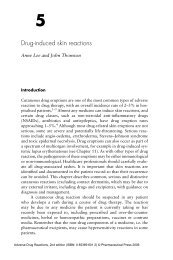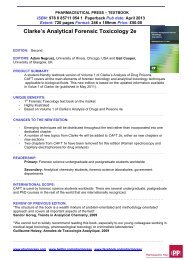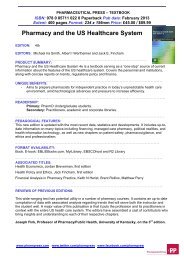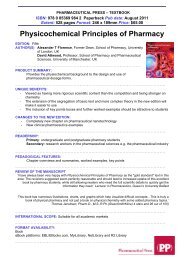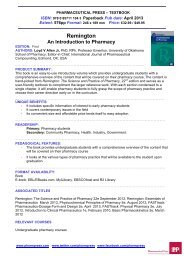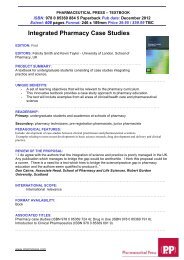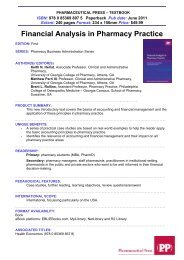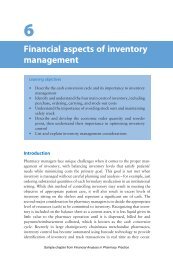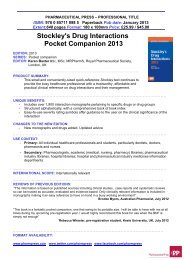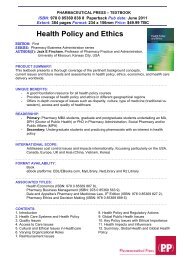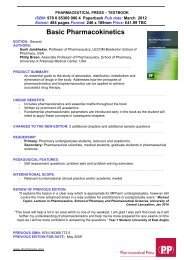6 Extravascular routes of drug administration
6 Extravascular routes of drug administration
6 Extravascular routes of drug administration
Create successful ePaper yourself
Turn your PDF publications into a flip-book with our unique Google optimized e-Paper software.
114 Basic Pharmacokinetics<br />
Mass <strong>of</strong> <strong>drug</strong> (mg)<br />
120<br />
100<br />
80<br />
60<br />
40<br />
20<br />
0<br />
Drug remaining<br />
to be absorbed<br />
Cumulative <strong>drug</strong><br />
absorbed<br />
0 2 4 6<br />
Time (h)<br />
Drug in the body<br />
Cumulative <strong>drug</strong><br />
eliminated<br />
Cumulative <strong>drug</strong><br />
excreted unchanged<br />
8 10 12<br />
Figure 6.10 Rectilinear (RL) plot <strong>of</strong> disposition <strong>of</strong> extravascularly administered <strong>drug</strong>, showing the fraction <strong>of</strong> <strong>drug</strong> unabsorbed<br />
versus time.<br />
Mass <strong>of</strong> <strong>drug</strong> (mg)<br />
100<br />
10<br />
1<br />
0.1<br />
Cumulative <strong>drug</strong> absorbed<br />
Drug remaining<br />
to be absorbed<br />
Time (h)<br />
Cumulative <strong>drug</strong><br />
eliminated<br />
Cumulative <strong>drug</strong><br />
excreted unchanged<br />
Drug in the body<br />
0 2 4 6 8 10 12<br />
Figure 6.11 Semilogarithmic (SL) plot <strong>of</strong> disposition <strong>of</strong> extravascularly administered <strong>drug</strong>, showing the fraction <strong>of</strong> <strong>drug</strong><br />
unabsorbed versus time.<br />
Integration <strong>of</strong> Eq. (6.21) from t = 0 to t = ∞ yields<br />
(XA)t = 1<br />
<br />
dXu<br />
+<br />
Ku dt<br />
K<br />
(Xu)t. (6.22)<br />
Ku<br />
From Eq. (6.18), we see that the first term to the<br />
right <strong>of</strong> the equal sign in Eq. (6.22) is equal to (X)t,<br />
the amount <strong>of</strong> <strong>drug</strong> in the body at time t. In the second<br />
term, (Xu)t is the cumulative amount <strong>of</strong> <strong>drug</strong> excreted<br />
by the kidney at time t. We may view the ratio K/Ku<br />
as a factor that will convert (Xu)t to the cumulative<br />
amount <strong>of</strong> <strong>drug</strong> eliminated by all pathways, including<br />
both renal excretion and metabolism. Thus Eq. (6.22)<br />
shows that cumulative absorbed <strong>drug</strong> is the sum <strong>of</strong><br />
<strong>drug</strong> currently in the body plus the cumulative mass<br />
<strong>of</strong> <strong>drug</strong> that has already been eliminated at time t.<br />
At t = ∞, the rate <strong>of</strong> urinary excretion <strong>of</strong> <strong>drug</strong><br />
is zero; so, the first term <strong>of</strong> Eq. (6.22) drops out,<br />
resulting in<br />
(XA)∞ = K<br />
(Xu)∞<br />
Ku<br />
Sample chapter for Basic Pharmacokinetics 2nd edition<br />
(6.23)<br />
where (Xu)∞ is the cumulative amount <strong>of</strong> excreted<br />
<strong>drug</strong> at time infinity.



